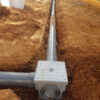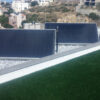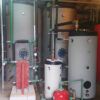Introduction
The principle that the past is the key to the future is particularly important when it comes to water resources. Archaeological and other evidence reveals that, during the Middle Minoan period, an unprecedented cultural explosion in the history of ancient civilizations took place on the island of Crete. This is demonstrated by the advanced techniques applied in water management during this period. It is striking that these techniques are also found in modern scientific areas of water resources, wastewater and groundwater hydrology. More specifically, they concern water networks and mainly those for residential use, in the construction, utilization and use of surface water, in baths and other related structures of sanitation and treatment, in the sewage and disposal systems of liquid waste and rainwater, in the restoration and irrigation of agricultural land and finally, the use of water for recreation. One of the most prominent features of the Minoan civilization is the architecture of the water supply systems and the systems for the drainage of waste and rainwater in the palaces and cities of that time. In the structure of most Minoan palaces and cities nothing is more remarkable than the complex and highly functional water supply and sewerage systems. In addition, in the same period there are indications for the use of liquid waste for the irrigation of agricultural crops (ca.3000-1100 BC).
Archaeological research suggests that the Minoan hydrologists and engineers were somewhat familiar with the basic principles of water resources and the environment, long before they were introduced in modern times. These technologies continued and improved during the Hellenistic and Roman years and at the same time spread to other cities of mainland and island Greece. Typical examples are the cisterns and other water supply facilities, as well as the baths, also called “hot springs” in Eleftherna, Aptera and Kissamos. Also of particular importance are the water tanks and baths in ancient Falassarna of the Hellenistic period and later the Venetian period.
Institutions of our country, such as research institutes, public services, water supply and sewerage companies, as well as various private companies dealing with relevant objects, have much to learn from the technologies of water resources and wastewater, which the ancient Cretans developed and applied in their settlements.
Cultural explosion
From the Neolithic era, Crete was inhabited by scattered populations that lived partly in caves some distance from the coast, but also in organized settlements. Although very little is known about the origins of these early settlers, their involvement in pottery and various handicrafts indicate their origins in Anatolia and possibly Egypt, rather than mainland Greece. The population of Crete increased at the beginning of the Minoan period, ie immediately after ca.3 000 BC, with the arrival of new settlers, perhaps from Asia Minor. In addition, linguistic and toponymic affinities are an indication of the affinity of the Cretan population with the Louvians, who in the Middle- and Late Minoan period, settled in Asia Minor.
Significant cultural progress was observed in Crete throughout the third and second millennium BC, while an unprecedented cultural and technological development was observed in the Middle Minoan period (ca.2 100-1 600 BC), when the The population of the island in the central and southern regions increased significantly, settlements developed, the first palaces were built, and in general a prosperous and uniform culture developed. By the end of this period, the arts, technology, handicrafts and trade with the island Aegean, Egypt and the Near East had evolved. In the early phases of the Late Minoan period (ca. 1600-1400 BC), Crete appears to be prosperous, as evidenced by the size of residential areas and houses, and the luxurious palaces of this period. The works of art, the development of metallurgy, the construction of advanced and equipped palaces and the excellent road system, certify the existence of a rich, highly cultured, well-organized society and government in Crete. The collapse of the Minoan civilization, with the destruction of the palaces is placed around ca.1400 BC. The palaces with the exception of Knossos were not repopulated. After the collapse, the continental influences on burial customs, armament, architecture but also art and language show that Mycenaean Greeks prevailed in Crete making the palace of Knossos an important center.
The serious and emerging “cultural explosion” from the early Minoan era that follows, refers to many cultural and scientific issues, typical of our time, such as architecture, urban planning, a socially human, hygienic and elegant way of life, progress in agriculture, forestry and shipping, environmental sensitivity and protection and more. This cultural flourishing was most intense during the relatively cold and wet periods.
In addition, it is no coincidence that plumbing and other technical projects related to river basin management, water resources development, baths and toilets, laundries, water storage and distribution tanks and sewerage networks, including the disposal of waste water. , have been made in various forms since ca.3000 BC. and after, (during the Early Minoan period). It is generally found that periods of intense social development and cultural upheaval, as well as the traditional criteria for selecting sites for settlement and development of local communities, are related to conservation conditions, elegance and the environment, food sufficiency and especially the availability of water resources.
The water resources technologies that were developed and applied in the Minoan period, despite the interruption observed in their development in the dark periods, seem to have followed an increasing course, which is observed in large-scale water resources projects, mainly during the Hellenistic period. This development continued during the Roman and Venetian periods, during which the implementation of water resources projects on an even larger scale is observed. .
Here are described the most important practices and technologies of water resources in periods of Ancient Cretan civilizations. Particular emphasis is placed on the Minoan civilization, which seems to be the beginning of the design and implementation of mainly water projects, arguing that the hydraulic engineers of that period were familiar with basic principles of water resources science (such as the flow of closed and open pipes and , as well as hydrogeology and hygiene). These technologies were further developed during the Hellenistic, Roman and Venetian periods.
The development of technologies
The cultural development, which appeared in different periods in Crete, covers many aspects, characteristic of the modern world, such as architecture, art, technology, navigation, agriculture, forestry and environmental protection. It was one of the most remarkable features of the Minoan civilization construction and use of sanitary facilities, as well as water supply and drainage systems for rain and liquid waste in palaces and cities, with advanced architecture and hydraulic operation. Perhaps the most impressive element of the palace of Knossos is the elaborate water supply and sewerage systems, which cross the entire interior of the palace.
Indicative technologies that were developed during this period are the following:
Aqueducts. From the Minoan to the Venetian period, more than 40 aqueducts are known in ancient Crete. The first aqueducts are located in Minoan Crete, which are probably the first in the history of mankind. Such are the aqueducts of Knossos, Malia, Tylissos and others. Several aqueducts were built and operated during the Hellenistic and Roman periods.
Tanks (Cisterns). Five cisterns are known from the Middle- and Late Minoan period (ca.2000- 1200 BC); two in the Myrtos Tower and one in the central square of the palace of Zakros, in the Spiders and in House C. These technologies were developed from earlier types such as that of the house in Hamaizi and were further improved in later civilizations and had significant development, mainly in Eastern Crete until the middle of the last century.
Wells. Wells were also developed during the Middle Minoan era (ca. 2000-1550) in the area of the “palace” of Knossos. The use of wells was more extensive in Eastern Crete due to limited surface water resources. Thus, in palaces and cities, such as Zakros, Paleokastro and Itanos, the use of groundwater was mandatory. Groundwater use technologies continued and were further developed in later civilizations. This technological development created an important tradition throughout Crete with the result that even today the water economy of the island is based on groundwater.
Other Facilities. In the ancient Cretan cultures, other hydraulic installations were also developed, such as clay pipes of various cross-sections and dimensions, open or closed, lead pipes of various dimensions, inverted P-shaped stone pipes and built gravity pipes, mainly in gravity systems.
The water supply of the Minoan settlements
The water supply conditions of palaces and other residential installations differ not only depending on the time periods, but also depending on the hydrological conditions of each area. Thus, the basic Minoan technologies and practices that were applied are divided into three main categories:
- a) In areas with relatively high altitudes and lack of groundwater aquifers and other water sources the water economy was based on the collection and storage in underground reservoirs during rainy seasons. In these cases, it is typical to arrange squares, courtyards and other open spaces properly, so that they are thoroughly cleaned before the collection process by carefully creating substandard collection grooves or special clay pipes, which, however, do not affect other functions of the considered spaces. Also, next to the storage tanks, sand refineries are constructed for the treatment of surface water before its storage in elegant, protected and highly functional underground tanks. Such facilities are observed in Phaistos, where no other water sources were available. It is noted that Professor M. Defner describes narrow and long clay structures (hydraulic filters) with small holes at one end, which were probably used as small refineries at the water outlets from the aqueducts. The turbulent flow of water creates relatively small pressures on the outer perforated walls due to the high flow rate. Thus, the effluent is freed from soluble and soluble solids (Figure 1).

Figure 1. Minoan water filter (Defner, 1921).
- b) In areas with spring water, the transfer of water supply to palaces and other residential areas was not done with built pipes like in the Venetian occupation and later during the Turkish occupation but with clay pipes carefully constructed, so that they are connected to each other with special synthetic material. . The pipes were conical in shape, about 76 cm long. Their shape facilitated their connection and had a significant effect on reducing the deposition of salts on their walls in cases of water with increased pH. Such closed pipes were used in the palace of Knossos for the transportation of water water initially from the source “Mavrokolympos” and later from other neighboring sources. Also, the same technology was applied to the distribution of water in palaces and other residential areas.
- c) Finally, in areas with underground aquifers, such as the palace of Zakros and the city of Paleokastro, the technology of drilling and pumping water from wells seems to have been quite developed. The technology used to pump the water from the wells was also admirable
The water supply of settlements in Hellenistic, Roman and Venetian times
The tradition and technology of water resources management of the Minoan period continued and was completed during the Hellenistic and Roman periods (330 BC – 330 AD). Thus, the quality of the clay water pipes and the technology of the aqueducts and tanks were significantly improved. Typical examples in Crete are the system of distribution and purification of water supply in Roman Kissamos, the water supply tanks of ancient Polyrrinia and the aqueducts of Hersonissos and Lyttos.
The water reservoirs of Driros, Latos, Eleftherna and Aptera are of special importance and significance. Each of them is a project of particular importance, with special technical characteristics that, even today, technical scientists can learn from their construction, collection, transport of water and water distribution systems for urban use. At the same time, the only port projects in the history of mankind in ancient Falassarna were built and operated, which include domestic tanks, baths and an aqueduct.
The management of water resources continued and improved even more in the Venetian period. Thus evolved, for example, the technologies of aqueducts and reservoirs, imposed by population growth and of course the increased water supply needs. A typical case is the construction of the well-known “Morozini aqueduct” which began in early 1627 and was completed in April 1628, due to the very pressing water supply needs. With this aqueduct, 15.64 km long, water was transported from the foothills of Yukhtas (Karydaki area) to the center of Heraklion. One of the destinations was the fountain of “Morosini” better known by the unfortunate name “lions”. In this used was the water of the springs Grammata, of Agios Ioannis of Myristis and of the monastery of Panagia of Karydiani. The project followed the route of the water bridges of Karydaki and Fortetsa and reached the New Gate. From there it went parallel to the wall, passed behind the “Hill”, and with a water bridge behind Lazaretou, ended at the site of the current Archaeological Museum. From there he took the “Three Arches” (location of today’s Astoria hotel), and with a tunnel from the old wall ended through the Vikelaia Library to the “Morozini” fountain. Other important fountains were built during this period, such as the Bembo, the Sagredo and the Priuli. The operation of the aqueduct stopped with the beginning of the siege of the city by the Ottomans in 1648. Another example is the water tanks of mainly fortifications and military installations, such as those on the island of Gramvousa, on the hill Vigla Viannou and elsewhere. These tanks are characterized by the perfection of their construction and their sizes in relation to the available drainage surfaces.
The use of water for recreation and creating an environment
The first indications for the use of water for recreation go back to the Minoan civilization. The hydraulic engineers of that period seem to have had enough knowledge and developed technologies for the use of water for recreation and improvement of the environment. Various findings indicate the existence in the “palaces” of this era of fountains, water jets, fish farms, aquariums and other related facilities. The first serious indication in the history of ancient Greek cultures of the use of water for recreation, is part of a representation, discovered at the “House of Murals” in Knossos and represents a type of fountain or jet of water “jet d ‘eau”, which is on display today at the Archaeological Museum of Heraklion.
Another indication of a similar use of water is the underground, circular (7 m) diameter tank that was discovered in the central part next to (along) the so-called Royal Department of the “palace” of Zakros. The room where the tank is located is called the “Tank Room”. Various theories and views have been put forward about the use of this tank, such as its use for swimming, as an aquarium or for religious ceremonies. Today it is believed that this tank had multiple uses, including recreational ones.
Baths and Other Sanitary Facilities
In the Minoan palaces bath drains were not always necessary, although useful. In fact, most palaces did not have such pipes. Although the functionality of the rooms is difficult to determine, Evans identified three rooms in Knossos as bathrooms. Baths and water tanks were necessary places in the Minoan settlements, places sacred for purifications, something similar to Christian purifications. The reservoirs of purifications were necessary in all the Minoan settlements, because the Minoan religion required the faithful to always be clean (Plato, 1990). Typical are the facilities in the “Caravan Serai”, located opposite the main entrance of the palace of Knossos. There was always water available from the aqueduct of Knossos to clean the visitors. There was also the so-called “sacred fountain”.
The basic type of bath is the one found next to the dining room of the queen of the palace of Knossos. This type is similar to the baths found in Phaistos and Malia. The difference, however, is that the floor of the palace of Knossos was not at the lower level. Parts of the clay pipes were found just outside the door of the room. Apparently the water was passing through a small canal on the floor, which started right outside the bathroom door. A duct under the floor connected the opening to the clay duct below the basin (Figure 2). The toilet could also be cleaned even during a summer drought, either by someone else or by the user himself. In Knossos there was a second toilet upstairs just above the room of the stone throne in the SW corner of the palace.

Figure 2. Section and floor plan of the toilet on the ground floor of the palace of Knossos (Angelakis et al., 2005).
Toilets of similar use to those of Knossos, existed in Phaistos, Malia, as well as in other settlements. A house in the area of the palace of Malia has a toilet seat in almost excellent condition, since it was built of solid stone, like that of the palace of Knossos. This stone seat had dimensions 68.60 – 45.70 cm wide and 35 – 38 cm high from the floor. It has been built directly opposite an external wall, through which a spacious sewer pipe passes. In Knossos it is obvious that its use was for a seat and not for a support. In addition, it looks more like the Egyptian toilets than the “Turkish type” toilets found in Mari’s palace on the Euphrates. A similar toilet has been discovered on the west side of the so-called “queen’s apartment” in Phaistos, which was connected to a small sewer, part of which still exists. Another toilet pipe was discovered in house C, in Tylissos. Similar facilities have been reported in other parts of Minoan Crete.
On certain days of the year, as mentioned above, sewers and toilets in the palace of Minos had to be adequately cleaned with rainwater collected in storage tanks. In fact Evans noticed that at one end of the seat there was enough space to place a large jug. With these data he concluded with obvious satisfaction that sewerage systems and other sanitary facilities such as those that existed in Knossos do not have many nations even today, that is, after some 4,000 years.
The baths in the baths of Minoan Crete must have been filled and emptied by hand. However, a footbridge from “Caravanserai”, at southern part of the palace of Knossos, was filled with water from a pipe of the water supply system and its overflow was drained by another pipeline. In addition, many of the baths may have had other uses, such as storing clothes. Plato (1974) and Graham (1987) report that purgatory tanks were used to purify the body, and symbolically the soul. Most baths of the Minoan period were associated with independent external septic systems, a practice indicative of the advanced management of water resources and the environment of that period.
Sewerage Systems
One of the remarkable features of the Minoan civilization was the architecture and the hydraulic operation of the sewerage systems in the palaces and other settlements. Of all the infrastructure of the Minoan palace at Knossos, nothing is more remarkable than the complex but highly functional sewer systems that run through the municipal facilities of the cities and their neighboring neighborhoods. Evans (1964) and MacDonald and Driessen (1988) reported on the course of these pipelines and designed their possible original form, with particular reference to their architecture. This plan provides the visitor with a basic orientation of the site and helps him to have a complete understanding of the whole network. The total length of the sewer system, including its main and secondary pipes, exceeds 150m. The small size of the pipes in some of its sections, the slopes and the angles prevent the detailed investigation of the network.
From a part of the main courtyard of the palace of Minos, the surface water was collected from a very large underground tunnel, built of stone, which passed under the corridor leading to the northern entrance and in which the liquid waste from various was drained. neighborhoods. The most explored part of the palace drainage system is the basement section of the palace, which formed a large circle, with its highest point located below the storage tank, next to the large staircase, east of the palace. Toilets, such as those mentioned above, were probably even cleaned with rainwater. Vertical pipes collected water from the terrace and probably distributed it to the toilets on the top floors. The pipes, built of treated stones, were large enough to be cleaned and maintained. There were actually small openings for this purpose. Duct openings helped to vent them.
In general, the plumbing and especially the sewerage and water pipes in the Minoan cities were designed “perfectly”. It has been proven that in many cities the sewer systems, covered with stone or built of marble, drained the liquid waste together with the rainwater. Rainwater was also collected from building roofs in storage tanks and used to clean sewers and toilets.
Finally, in the villa of Agia Triada, the most advanced sewerage system was discovered, both of the liquid municipal waste and of the rainwater in the whole history of the Minoan civilization. In the early 20th century, it is reported that the author Angelo Mosso visited this settlement during a heavy downpour and observed that the entire sewer system worked perfectly because of the hydrodynamic propulsion created by the altitude difference and the shape of the pipeline. Mosso, who was also a well-known hygienist, recorded the incident, saying: “I doubt there is another case of a rainwater drainage system operating 4,000 years after its construction.” The American Gray (1940), who conveys the story, adds: “Perhaps we can be allowed to doubt whether modern sewer systems will work in at least a thousand years.” Therefore, the Minoan plumbers planned and implemented projects that operated for many centuries, in contrast to today when the operation of a project for 40-50 years is considered satisfactory.
Sophisticated sewer systems existed in other Minoan cities and palaces, such as those of Phaistos and Zakros. The sewerage system of Zakros was quite dense and of high standards. As in Knossos, so in Zakros the main sewers were made of stone and large enough to allow passage for cleaning and maintenance. The smaller conduits were ceramic. There are indications that the system was not effective during periods of heavy rainfall, although the location of the area, on a natural slope, is favorable for rainwater drainage.
The exits of the sewerage systems of palaces and cities, such as Knossos, Phaistos and Malia seem to be similar. The waste disposal areas in the palaces of Knossos and Zakros were in the Kairatos torrent and in the sea, respectively. In the palace of Phaistos, the first tanks for the collection, storage and reuse of rainwater are mentioned. Similar drainage and rainwater collection techniques are reported in other cities and palaces of Minoan Crete. Typical is a rectangular rainwater storage tank (dimensions 1.6 × 2.0 × 6.0 m³) in Agia Triada. The water from this tank was probably used for washing or other household uses. There are also indications that in the palace of Phaistos and in the villa of Agia Triada, in addition to the use of rainwater, discharges of municipal liquid waste were disposed of in agricultural areas. As it is known, Crete does not have a rich water potential, while several periods of the Minoan civilization must have been characterized by severe water shortages. Therefore, water reuse was a necessity. Thus, it seems that bath water could be reused for irrigation of gardens and agricultural areas.
Moreover, it is known that in the Minoan era the agricultural development of Crete was necessary in order to be able to support the population explosion. In the neo-palace period (ca.1750-1490 BC) the practice of irrigation was particularly important. From the irrigation systems that were developed at that time, the most famous is the one called Linies (from the word linea = straight line), which was located on the Lassithi plateau. The Lassithi plateau was definitely irrigated from the Minoan period. This can be deduced from the Neolithic and Minoan settlements found in Papoura, Kastelos, Plati and Karfi as well as the famous sacred caves at the top of Kronion in Trapeza and Diktaio Andros in Psichro. There the numerous drainage channels and irrigation ditches intersect and create a remarkable shape. This technique is considered to have been later transferred by the Minyas to Central Greece.
Epilogue
This monograph attempted a first description of current finds in ancient Cretan settlements, related to water resources projects. Their importance is based (a) on the perfection of structures and their operation many millennia ago (b) on the pioneering nature of many technologies, such as rainwater harvesting cisterns, aqueducts and residential systems, and (c) on transfer of these technologies to central Greece and other parts of the world. It is worth noting that later achievements of the ancient Greeks were based on technologies and practices of the ancient Cretans.
The following excerpt from a text by the American hygienist Gray (1940) fully reflects the great interest of the Minoans in water resources and wastewater technologies:
“We often hear people talk about ‘modern sanitation’ as if it were something recently developed and there seems to be a prevailing idea that urban sanitation is something very modern that was introduced somewhere in the middle of the last [19th] century. Perhaps these ideas try to strengthen a somewhat shaken pride in modern culture […], but when examined in the light of history it turns out that they are anything but new or recent. Indeed, in the light of history, it is astonishing, if not bitter, that man has progressed so little, perhaps not at all, in about four thousand years […]. Archaeologists of this [Minoan] site give us the impression that humans had come a long way towards comfortable and healthy living, with a special degree of beauty and luxury […]. And that was achieved about four thousand years ago. ”
Bibliography
- Alexiou, S., 1964. Minoan Civilization. Sons of Sp. Alexiou, Heraklion.
- Angelakis A.N. and Spyridakis, S. V., 1996. Wastewater management in Minoan times. In: Proc. of the Meeting on Protection and Restoration of Environment, August 28-30, Chania, Greece, p. 549-558.
- Angelakis, A.N., Koutsoyiannis, D., and Tchobanoglous, G., 2005. Wastewater management technologies in Ancient Greece. Wat. Res. 39 (1): 210-220.
- Angelakis, A. N., Savvakis, Y. M., and Charalampakis, G., 2007. Aqueducts During the Minoan Era. Water Sci. and Techn., Water Supply, 7 (1): 95-102.
- Castleden, R., 1993. Minoans: Life in Bronze Age Crete. Routledge, 11 New Fetter Lane, London, UK.
- Crouch, D.C., 1996. Avoiding water shortages: Some Ancient Greek solutions. In: Diachronic Climatic Impacts on Water Resources with Emphasis on Mediterranean Region (A.N. Angelakis and A.S. Issar, Eds.), Ch. 7: 129-159, Springer-Verlag, Heidelberg, Germany.
- Evans, S.A., 1921-1935. The Palace of Minos at Knossos: A Comparative Ac¬count of the Successive Stages of the Early Cretan Civilization as Illustrated by the Discoveries. Vols. I-IV, Macmillan and Co., London (reprinted by Biblo and Tannen, New York, 1964).
- Defner, M., 1921. “Late Minoan Refinery” Archaeological Journal, 78, Heraklion, Greece ..
- Graham, J.W., 1987. The Palaces of Crete. Revised Ed. Princeton University Press, Princeton, New Jersey, USA.
- Gray, H. F., 1940. Sewerage in Ancient and Medieval Times, Sewage Works Journal, 12 (5), 939 – 946.
- Huxley, G., 1961. Crete and the Luwians. Oxford, UK.
- Koutsoyiannis, D., Zarkadoulas, N., Angelakis, A. N., and Tchobanoglous, G., 2008.
Urban Water management in Ancient Greece: Legacies and Lessons. ASCE, Journal of Water Resources Planning & Manag., 134 (1): 45-54.
- Lyrintzis, A. and Angelakis, A. N., 2006. Is the “Labyrinth” a Water Catchment Technology? A Preliminary Approach. In: IWA Specialty Conference: 1st International Symposium on Water and Wastewater Technologies in Ancient Civilizations (A. N. Angelakis and D. Koutsoyannis Eds.), Iraklio, Greece, p. 163- 174.
- Mac-Donald, C.F. and Driessen, J. M., 1988. The Drainage System of the Do¬mestic Quarter in the Palace at Knossos. British School of Athens, 83: 235-358.
- Mays, L. W., D Koutsoyiannis, D., and Angelakis, A. N., 2007. A Brief History of Water in Antiquity. Water Sci. and Techn., Water Supply, 7 (1): 1-12.
- Panagiotakis, N. M., 1987. Crete: History and Culture. Βικελαία Βιβλιο¬θήκη. Association of Local Associations of Municipalities and Communities of Crete. Volume 1, p. 416.
- Platon, N., 1974. Zakros, The Neon Minoan Palace. The Archaeological Society of Athens, Athens.
- Platon, M., 1990. New indications for the problems of cleaning tanks and baths in the Minoan world. Proceedings of the 6th International Cretaceous Congress, Chania, A2: 141-155.
- Pendlebury, J. D. S., 1950. Guide to Knossos. Translation from Plato Prefecture, Heraklion.
Source:
Crete cities and villages 5:37:00 p.m.
A. Angelakis
Associate Researcher of ETH.IAGE. and Technical Advisor of the Union of DEYA,
Papakyriazi 37-43, 41222 Larissa, angelak2@vodafone.net.gr

 ·
· Ελληνικά
Ελληνικά



